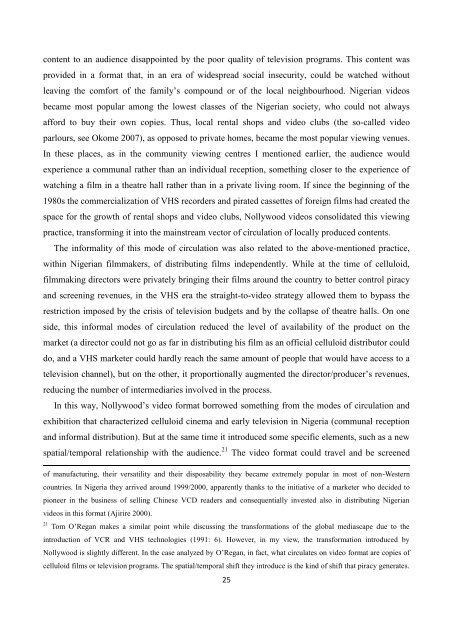You also want an ePaper? Increase the reach of your titles
YUMPU automatically turns print PDFs into web optimized ePapers that Google loves.
content to an audience disappointed by the poor quality of television programs. This content wasprovided in a format that, in an era of widespread social insecurity, could be watched withoutleaving the comfort of the family’s compound or of the local neighbourhood. Nigerian videosbecame most popular among the lowest classes of the Nigerian society, who could not alwaysafford to buy their own copies. Thus, local rental shops and video clubs (the so-called videoparlours, see Okome 2007), as opposed to private homes, became the most popular viewing venues.In these places, as in the community viewing centres I mentioned earlier, the audience wouldexperience a communal rather than an individual reception, something closer to the experience ofwatching a film in a theatre hall rather than in a private living room. If since the beginning of the1980s the commercialization of VHS recorders and pirated cassettes of foreign films had created thespace for the growth of rental shops and video clubs, Nollywood videos consolidated this viewingpractice, transforming it into the mainstream vector of circulation of locally produced contents.The informality of this mode of circulation was also related to the above-mentioned practice,within Nigerian filmmakers, of distributing films independently. While at the time of celluloid,filmmaking directors were privately bringing their films around the country to better control piracyand screening revenues, in the VHS era the straight-to-video strategy allowed them to bypass therestriction imposed by the crisis of television budgets and by the collapse of theatre halls. On oneside, this informal modes of circulation reduced the level of availability of the product on themarket (a director could not go as far in distributing his film as an official celluloid distributor coulddo, and a VHS marketer could hardly reach the same amount of people that would have access to atelevision channel), but on the other, it proportionally augmented the director/producer’s revenues,reducing the number of intermediaries involved in the process.In this way, Nollywood’s video format borrowed something from the modes of circulation andexhibition that characterized celluloid cinema and early television in Nigeria (communal receptionand informal distribution). But at the same time it introduced some specific elements, such as a newspatial/temporal relationship with the audience. 21 The video format could travel and be screenedof manufacturing, their versatility and their disposability they became extremely popular in most of non-Westerncountries. In Nigeria they arrived around 1999/2000, apparently thanks to the initiative of a marketer who decided topioneer in the business of selling Chinese VCD readers and consequentially invested also in distributing Nigerianvideos in this format (Ajirire 2000).21 Tom O’Regan makes a similar point while discussing the transformations of the global mediascape due to theintroduction of VCR and VHS technologies (1991: 6). However, in my view, the transformation introduced byNollywood is slightly different. In the case analyzed by O’Regan, in fact, what circulates on video format are copies ofcelluloid films or television programs. The spatial/temporal shift they introduce is the kind of shift that piracy generates.25
















